soziale stadt - bundestransferstelle
besonderem Entwicklungsbedarf - Soziale Stadt"
Nuremberg Galgenhof-Steinbühl
|
Cathy Cramer |
|
The Free State of Bavaria has established favourable framework conditions for the effective implementation of the programme "Districts with Special Development Needs - the Socially Integrative City." In 2000, an interdepartmental working group was set up under the overall control of the Supreme Building Authority in the Bavarian Ministry of the Interior to do justice to the underlying integrative principle of the programme. Inter-authority working groups were also set up at the level of administrative district governments, including the Central Franconian government in the summer of 2001. In order to support municipalities and actors, an aid to work for the "Socially Integrative City" programme was published (Oberste Baubehörde im Bayerischen Staatsministerium des Innern (ed.), Soziale Stadt - Wege zu einer intakten Nachbarschaft, Munich 2000). A brochure on the funding and support available for the "Socially Integrative City" programme areas is to follow. However, the allocation of funds in Bavaria is still governed by the Urban Development Directive (StBauFR). In accordance with this instrument, an urban renewal area must be official designated before it is eligible for inclusion in the programme. The Bavarian government recommends that "Socially Integrative City" municipalities set up a contingent fund from the resources of the programme for minor social and constructional measures.
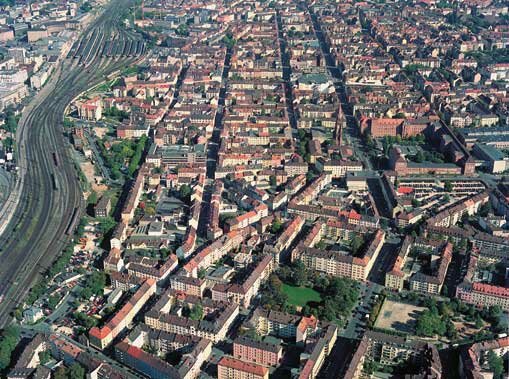 |
| The model area Galgenhof/Steinbühl (Source: Bischof + Broel KG, Nuremberg/Aerial photograph no. 2001-902-CR-B-43) |
The position of the Nuremberg municipality on urban renewal is based on the principles adopted by the city council as long ago as 1985 for the project "Ecological urban Renewal Gostenhof-Ost." New ground was broken at the time, which has now become part and parcel of the "Socially Integrative City" model, with a "holistic view of all the circumstances of life in the district" and supplementation of the "traditional" areas of action to include education, culture and recreation, household and consumer behaviour, social relations, etc., a concern with prevention not only with remedies, the strengthening of immaterial values (like identification with the district), the trying out of new forms of participation and collaboration, new forms of cooperation within administrative structures, and new forms of cooperation with external functional partners and district actors.
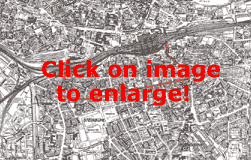 |
Boundaries of the model area Galgenhof/Steinbühl (Source: Nuremberg municipality) |
In 1994, preparatory studies were conducted for Galgenhof/Steinbühl in accordance with the Building Code. Since 1996, the district has been an officially designated urban renewal area. In 1998 the urban framework plan and the programme plan were published, and in 1999 the district was included in the Federal-Länder programme "Districts with Special Development Needs - the Socially Integrative City." Galgenhof/Steinbühl is part of the Nuremberg EU Objective 2 support area; it includes Südstadt (South Town) with a population of 60,000 and a corridor to the EU Objective 2 support area of the city of Fürth, with 9,000 inhabitants.
1. Nature of the Area 
The 61 hectare model area Galgenhof/Steinbühl lies to the south of the Nuremberg old city and is part of Südstadt. It is bounded on the north by the railway yards of the central railway station, the busy Gibitzenstraße to the west, Allerberger Straße to the east, and Landgraben/Wölckernstraße to the south. The structure of the working class neighbourhood is characterised by largely enclosed perimeter block development, two-thirds of which was constructed after the war, and scattered commercial and industrial uses. With a population density of 182 per hectare, Galgenhof/Steinbühl is among the most densely populated areas in Nuremberg.
Owing to favourable building sites, large industrial enterprises established themselves in Südstadt in the late 19th century (power station, Siemens-Schuckert works, etc.), making the area Nuremberg's most important industrial and commercial location. During the Second World War, the importance of the area attracted highly destructive aerial bombardment. In Galgenhof/Steinbühl more than two-thirds of housing was destroyed, to be reconstructed during the 1950s and 1960s.
Transport planning from the immediate post-war period - abandoned in 1984 - kept large areas of land along the railway lines undeveloped. These sites are now vacant or occupied by temporary uses. Given its enormous breadth (main station and additional lines), the railway land on the northern periphery of the programme area constitutes a major spatial barrier, isolating the area from the inner city.
2. Main Problems and Development Potential 
High on the list of problems facing the district are the massive job cuts in manufacturing and a series of plant closures that have occurred in recent years. In commerce, too, the number of jobs has decline more strongly than in the city as a whole. The 10.3% unemployment rate is markedly higher than in the over-all municipality (about 7.1%). Almost half the jobless (48.5%) are migrants (compared with on 33% in the whole of Nuremberg). The share of women is about 40%. Some 29% are classified as long-term unemployed (over a year). Moreover, the number of low-paid and insecure jobs is particularly high. This was stated by almost 20% of respondents in a social survey conducted by the University of Erlangen-Nuremberg, especially people in the 14 to 25 age group and of non-German origin; although this is less the case for Turkish migrants. In comparison with the city as a whole, the level of education is much lower, and there is a higher proportion of young unskilled or poorly trained foreigners.
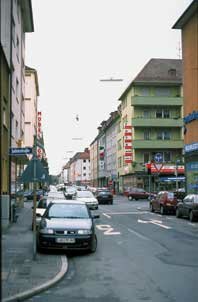 |
Perimeter block development, hardly any street land planting, and heavy traffic. (Source: Wolf-Christian Strauss, Berlin) |
Although the model area has a shopping and services centre on Aufseßplatz of more than local importance, the lower average household net income in Galgenhof/Steinbühl (20% below the city average) has an increasingly unfavourable impact: shop premises are increasingly being taken over by discount chains or are standing vacant.
Among the main obstacles to modernisation of the housing stock, courtyard planting, and redesign in the context of integrative district development are the very heterogeneous ownership structure and the fact that most landlords do not live in the area. Many dwellings in post-war buildings are small and not up to modern standards. There is a great need for rehabilitation and modernisation. The plain facades and lack of greenery in street spaces produce a monotonous cityscape.
Local environmental quality suffers from heavy traffic, noise, air pollution (car exhaust gases, domestic heating), obsolescent heating systems, inadequate thermal insulation. The very high density of development, with residential buildings, garages, parking areas, and other courtyard uses means a high rate of soil-surface sealing. The lack of green and open spaces and of possibilities for block ventilation also negatively influence the micro-climate and air quality in the district.
Demography and Social Space
|
Galgenhof/Steinbühl |
Nuremberg |
|
|
Size |
61 ha |
18 640 ha |
|
Population (1999) |
11 138 |
486 628 |
|
Population decline (1995–2000) |
2.7 % |
0.9 % |
|
Average household size (1998) |
1.7 pers. (2000) |
2.0 pers. (1997) |
|
Number of dwellings (1999) |
6 534 |
254 012 |
|
Vacant dwelling units |
not relevant |
not relevant |
|
Housing benefit recipients (1999) |
n.a. |
34 623 |
|
Unemployment rate (2000) |
10.3 % |
7.1 % |
|
Social assistance recipients (2000) |
9.0 % |
5.3 % |
|
Foreign population (1999) |
33.5 % |
18.1 % |
|
Population under 18(1999) |
11.7 % |
12.7 % |
|
Population 60 and older (1999) |
14.0 % |
17.7 % |
In Galgenhof/Steinbühl, the state of children's health - as revealed by examinations in schools - is markedly worse that in the city as a whole, for example, as regards overweight, bad posture, dental health, respiratory diseases (asthma, bronchitis), and allergies (neurodermatitis).
Although there are about 100 social and cultural institutions in Galgenhof/Steinbühl and surrounding areas, the district is badly served in certain infrastructural areas: e.g., facilities for senior citizens are spatially concentrated and thus not easily accessible for many older people.
Despite the problems facing the area, it has great development potential for improving and stabilising local living conditions. This includes the central, inner-city location and easy access by public transport from all parts of the city. Areas within blocks offer large ground surfaces for de-sealing, partial clearance, and redesign. Derelict sites can be put to temporary use.
Local business people's associations are developing ideas on expanding the Südstadt festival and staging a "shopping festival." Changes in use for industrial locations in Südstadt offer potential for internal industrial and commercial development, conversion and substitute activities, the establishment of small industrial enterprises, restaurants, and a private (cultural) scene.
Major potential is offered by the willingness of the Galgenhof/Steinbühl population to participate and the engagement of numerous facilities, institutions, and organisations. Young people show particular engagement for specific projects. According to the latest survey of residents and institutions, migrants are also willing to participate and become involved.
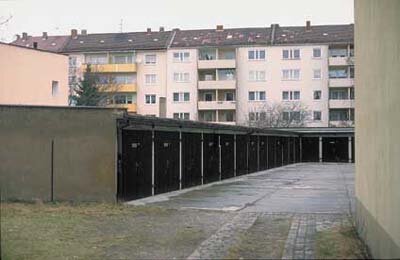 |
Major surfaces are available for ground de-sealing within blocks. (Source: Wolf-Christian Strauss, Berlin) |
Furthermore, since local residents are apparently quite satisfied with the dwelling situation, their commitment to the area, the reduction of population fluctuation, and identification with the district can feasibly been achieved; senior citizens and the young, in particular, feel attached to the area and like living there.
3. Development Goals and Focal Points of Action 
The first objectives for urban renewal, which had been launched in 1996, were established by the preparatory studies. They were primarily concerned with (urban) development activities, and were incorporated in the "Südstadt" development plan as revised between 1996 and 1998. The programme and framework plan followed in 1997/98, introducing additional areas of action.
Areas and Goals of Action
|
Areas of Action |
"Socially Integrative City" goals of action |
|---|---|
|
Local work/qualification |
Improving opportunities for young people and the unemployed |
|
|
Close-to-home training positions and jobs |
|
Retailing, industry, commerce |
Strengthening the retail trade |
|
|
Safeguarding small-scale industrial and commercial structures |
|
|
Resolving conflicts with residential uses |
|
Health |
Preventive measures |
|
|
Improving knowledge about health |
|
|
Promoting health projects |
|
|
Reducing factors harmful to health (industrial emissions) |
|
Culture and recreation |
Promoting living together of different cultures |
|
|
Development of services and amenities for different target groups |
|
|
Expanding cultural amenities (district events) |
|
|
Improving facilities for recreation, sport, and play |
|
Integration |
Support for and integration of foreign families |
|
|
Advising foreign families in difficult situations |
|
Families |
Support and advice for families and single parents |
|
|
Assistance for families in difficult situations |
|
Senior citizens |
Improving contact opportunities |
|
|
Improving services |
|
Children and young people |
General support for children and young people |
|
|
School help |
|
|
Support for disadvantaged children and young people |
|
|
Reducing the lack of day-care facilities |
|
Housing and dwelling environment |
Façade design and planting |
|
|
Safeguarding housing stock and socially acceptable rents |
|
|
Preserving low-cost housing |
|
|
Conversion of old heating systems |
|
|
Planting courtyards |
|
|
Block perimeter closure, constructional rounding-off |
|
|
Development of underused land |
|
Green and open spaces |
Reducing lack of green spaces and play areas |
|
|
Better design for existing amenities |
|
|
Interlinkage of existing amenities |
|
|
Improving sojourn quality in streets and public squares |
|
|
Reorganisation and planting of inner areas of blocks |
|
Construction of new sports grounds |
|
|
Traffic |
Extension of parking places/neighbourhood garages |
|
|
Improving and supplementing pathways and cycleways |
|
|
Safeguarding school routes |
|
|
Organisation of public parking |
|
|
Upgrading street space through planting and square design |
|
Image enhancement |
Strengthening identification with the residential area |
|
|
Upgrading the district |
|
Citizen participation, communication and district work |
Involving all population groups and networking all actors |
|
|
Motivating residents |
|
|
Strengthening self-organisation and self-help |
After implementation of a range of measures in Galgenhof/Steinbühl and transfer to the Federal/Länder programme "Socially Integrative City," the results of the preparatory studies were updated in the winter of 2000/2001 and supplemented by an activating survey of residents and civic action groups (including figures on unemployment and social-assistance dependence, rent levels, demands and wishes for the future development of the area).
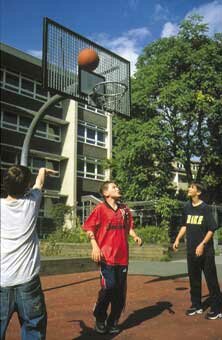 |
The redesigned school grounds are very popular (Hummelsteiner Weg School) (Source: Wolf-Christian Strauss, Berlin) |
The urban renewal areas of action and objectives were revised and supplemented by fields that included "integration," "image enhancement," and by development goals. An integrated plan of action is not currently available. It is to be drawn up by the municipality and the neighbourhood management set up in autumn 2001.
For the purpose of implementing the "Socially Integrative City" programme, the following objectives were added:
- The area is to looked at holistically;
- Sustainability is to be kept in mind;
- New areas of action and new actors are to be mobilised;
- Public relations and citizen participation are to be strengthened;
- External competence and cooperation are also to be relied on;
- Action is to be taken on administrative organisation, resource bundling and management in the neighbourhood.
4. Key Projects 
Owing to their value for the favourable development of community life in the district, the following projects and measures are to be regarded as equally important key projects for integrative development in Galgenhof/Steinbühl.
The "Südstadt Green Offensive" project proposes the integrated design and extension of green and open spaces along a north-south axis and an east-west axis. The project includes public squares and parks, public and school playgrounds, and the planting of street land. It will cooperate closely with the "Green Ribbons working group." Users are to participate in all redesign activities.
Between 1996 and 2000 a derelict site near the central railway station was converted into the 11,900 square metre Südstadt Park. It includes a playground and a fountain in Karl Bröger Square, the product of an art competition.
To remedy the lack of play areas in Galgenhof/Steinbühl, the school grounds of the Hummelsteiner Weg School and the Wiesen School were converted into "play-yards" between 1997 and 1998 with the collaboration of children, adolescents, teachers, and parents. The designation as "play-yard" allows the play areas to be used outside school hours.
Because of its outstanding importance for Südstadt, the public square Aufseßplatz is to be redesigned. In autumn 2001, a competition was carried out for this purpose. The district was represented on the jury by two members of the Galgenhof/Steinbühl "Opinion Leaders' Circle." The winning design is to be realised from 2002.
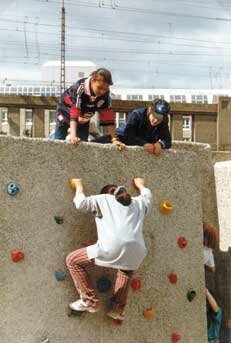 |
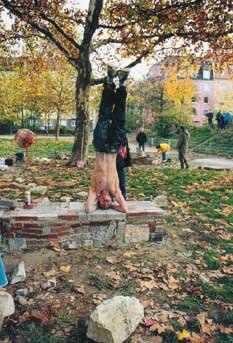 |
| Opening of the playground in Südstadt Park. (Source: Barbara Schatz, Office for Housing and Urban Renewal/Nuremberg Municipality) |
|
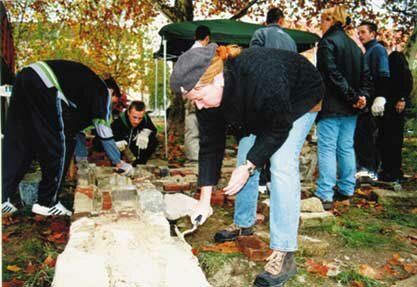 |
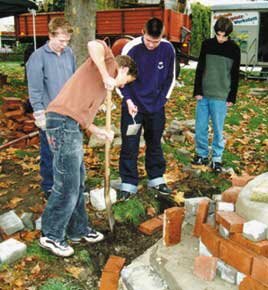 |
CAMP project (Sources: Barbara Schatz, Office for Housing and Urban Renewal/Nuremberg Municipality,Heike Wolff, Child Welfare Office/Nuremberg Municipality) |
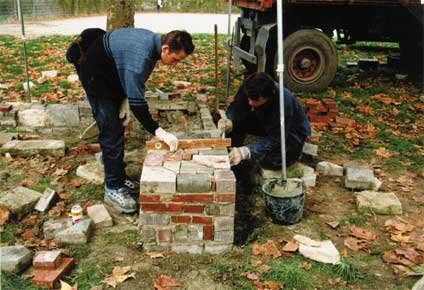 |
Eleven young people (including two girls) with a low level of vocational training and who have been unemployed for some time are improving their occupational qualifications with the aid of the "Voluntary Social Training Year" at the "Job-Lokal" qualification bureau of the firm Noris Arbeit gGmbH (NoA). This is a non-profit Nuremberg municipal employment company with local responsibility for the programme platform "Development and Opportunities for Young People in Deprived Areas."
The "Südstadt Service and Social Forum" is planned as a facility for low-threshold activities and services in the neighbourhood. Occupying the premises of a former hardware dealer in the quarter bounded by Peter-Henlein-Strasse, Siebenkeesstrasse, and Bogenstrasse, the District Centre was installed in the spring of 20001, housing the office of the district management as well as a citizens' meeting room, the NoA office with a lost property office, a second-hand furniture store, and a bicycle repair shop as a job creation project for social assistance recipients, and the "Voluntary Social Training Year" training bureau "JOB-LOKAL." The approximately 3,000 square metre property is to be bought and developed to accommodate other activities, like partial use by the "Intercultural Südstadt Centre" planned by the Workers' Welfare Organisation, an Internet café, and a counselling service for ethnic German immigrants.
At Wiesen School, the recess hall, which has been little used, is to be developed to house a social-pedagogic counselling bureau. School staff and the General Social Service (ASD) are to provide an interdisciplinary team of experts (consultant teacher, school psychologist, district social educationalist, special services) on at least four days a week to advise children, young people, and parents. The catchment area is extend beyond Wiesen School to include the entire district. The recess hall also has room to accommodate a midday care service for the children.
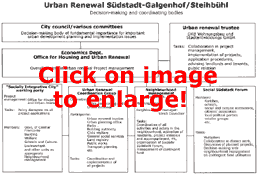 |
Urban renewal coordination in the model area Galgenhof/Steinbühl (Source: Office for Housing and Urban Renewal/Nuremberg Municipality) |
In the "Südstadt Kids" project, young people from Hummelsteiner Weg Secondary School produce radio programmes like interviews, reports, commentaries, or features for the independent local radio station Südpol in cooperation with the alternative scene station Radio Z. They report on activities and events in Südstadt and Galgenhof/Steinbühl.
The aim of the "Sonnentaler" project is to promote civic engagement among children and adolescents. They take on duties like baby sitting, coaching, shopping for the elderly, and are rewarded with tokens called "sun thalers" which they can exchange for offerings on the sun thaler exchange (e.g., computer courses, fitness training). The project, launched in April 2000 and which has already won two awards, was extended to the model area in cooperation with Hummelstein Weg Secondary School. So far, the project has been managed on a volunteer basis by a member of staff from the Workers' Welfare Organisation district youth organisation. Now it is to be reorganised on a new basis with two staff positions and support from the "Socially Integrative City" programme.
5. Organisation and Management 
Before inclusion in the "Socially Integrative City" programme, there had already been two coordinating units for the renewal process at the administrative level under the control of the Office for Housing and Urban Renewal: first, the project group Housing and Urban Renewal, in which units concerned with development and urban renewal are represented (Planning Staff for Urban Development, Welfare Division, Building Division, Building Authority, Land Office, Urban Planning Office, Land Registry, Environmental Office, Office for Statistics and Urban Studies), in which fundamental urban development issues are discussed; second the Urban Renewal Coordination Group (KOG) which includes representatives from units relevant for implementation (Parks Department, Child Welfare Office, Building Construction Office, Public Works Department, Urban Renewal Trustee, Office for Culture and Recreation, General Social Services, Health Department, Senior Citizens' Office). In the spring of 2001, the "Socially Integrative City" working party (AK) was set up for all Nuremberg programme areas under the overall control of the Office for Housing and Urban Renewal. The monthly meetings are also attended by representatives of the Central Franconian government, the housing company as solely landlord in the northeast station areas, the programme area neighbourhood managements, and the German Institute of Urban Affairs "local programme support team." This working party discusses and adopts all new projects. The KOG coordinates implementation.
The Office for Housing and Urban Renewal has established a project management for project conception and financial management. It is supported by the urban renewal trustee, whose functions include, above all, the implementation of urban renewal measures in the model area.
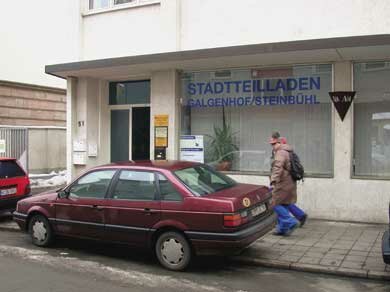 |
District Centre and neighbourhood management office in Paeter-Henlein-Strasse (Source: Wolf-Christian Strauss, Berlin) |
The intermediary area is constituted by the "Opinion Leaders' Circle," set up in 1996 to accompany traditional urban renewal, and consisting of 15 to 25 personalities from the district. Also belonging to the circle are some members of the city council and local associations at the neighbourhood level as representatives of the political parties in the council. Since greater resident activation and participation are demanded by the "Socially Integrative City" programme, the Office for Housing and Urban Renewal initiated enlargement of the "Opinion Leaders' Circle" in 2000 (to include representatives of parents, senior citizens, residents of various nationalities, members of sports clubs) to constitute a district working party with greater influence. In the spring of 2002 a first workshop of the former "opinion leaders' circle" (now "Social Südstadt Forum") is to take place with the neighbourhood management to work out new objectives and tasks for the body.
In October 2001 a neighbourhood management was set up for Galgenhof/Steinbühl. Its functions include coordinating all the activities and actors in the neighbourhood, developing suitable strategies for activating residents, initiating and accompanying projects, public relations, drawing up an integrated plan of action, organisation the "Opinion Leaders' Circle," and managing the contingent fund. The neighbourhood management has its office in the District Centre opened in May 2001 in Peter-Henlein-Strasse. It replaced the information and contact point "InfoBox" set up in the first phase of urban renewal from 1997 to 2001 on Südstadt Park. The premises are also used by the "Social Südstadt Forum" and are available for use by project groups.
In addition, there is the cultural centre "Südstadtladen," somewhat outside the model area, which has been a contact and integration point for citizens for over a decade. A unit of the Office of Culture and Recreation, it organises successful activities in the Sudstadt like the Südstadt debates and the Südstadt festival in Annapark, which has been staged for the past 20 years.
6. Activation, Participation, and Public Relations 
Efforts to achieve activation and participation were stepped up with the start of implementation for the "Socially Integrative City" programme in 1999.
The most important activation strategies deployed to date in Galgenhof/Steinbühl include offers of premises to groups and initiatives in the District Centre, support for resident activities, bodies, and civic action groups, the establishment of standing cooperation structures by the neighbourhood management, outreach work and open youth work by the municipal social and child welfare units and private organisations, a survey conducted by the University of Erlangen-Nuremberg among local residents and institutions, information events for multipliers on the "Socially Integrative City" programme and urban renewal in Galgenhof/Steinbühl, and opportunities for residents to participate in implementing projects.
Particularly important for activation has been the contingent fund on hand for the model area to an annual amount of Euro 25,500. The employment of this money is decided by the "Social Südstadt Forum" together with the neighbourhood management.
Among the most important offers for participation are citizen events concerning information and collaboration on planned projects (e.g., the competition for redesigning Aufseßplatz and converting school grounds into play areas), the presentation and discussion of the findings of the current survey of residents and institutions, and presentations at the Südstadt festival or on Aufseßplatz. Two successful future prospects conferences, which attracted about 200 participants, and a series of other events with participatory aspects also took place within the framework of the EU Objective 2 process.
In addition to the forms of participation that have met with approval in the past, other, more strongly bottom-up forms and more intensive local activation are wanted by actors in the urban renewal process. Much is expected in this regard from the further work of the neighbourhood management.
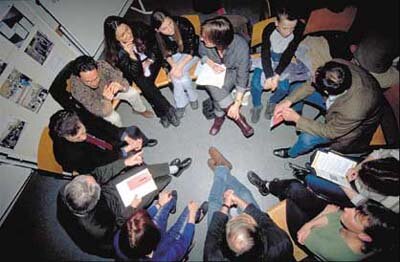 |
Committed citizens at the event "Life in Galgenhof/Steinbühl - What lies Ahead for the District?" held in April 2001 (Source: Wolf-Christian Strauss, Berlin) |
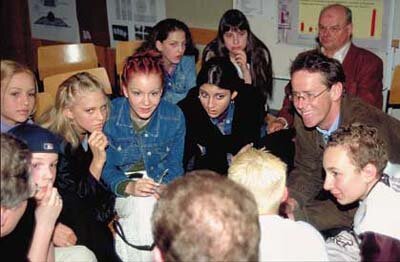 |
The wide-ranging public relations work conducted by the Nuremberg municipality for the model area includes printed information material: comprehensive colour brochures, such as "Südstadt Development Concept," "Urban Framework Plan and Programme Plan," "Supplementary Preparatory Studies, Socially Integrative City," and the biennial brochure on urban renewal. Information sheets and reports, sometimes multilingual, are published on individual projects and events, using a layout and logo common to all Nuremberg urban renewal areas. Furthermore, the Nuremberg municipality has brought out a number of publications on the programme and on events in the context of the EU Objective 2 process. In 2000, an Internet site was developed [www.suedstadt.nuernberg.de], and in autumn 2001 a logo "Future Südstadt." Online information can also be obtained at www.wohnen.nuernberg.de.
7. Conclusion: Turn to the south 
Since the beginning of the "Socially Integrative City" programme, the new projects in the model area have broadened the scope of action from constructional measures towards multi-objective projects. A particular contribution to this shift was made by the early engagement of the two schools in the area and their project ideas. A next important step towards transparency in the timing and content of the process and towards winning the approval of residents, citizens' groups, and local business for programme goals and measures is to draw up the integrated plan of action, i.e., the further development of the objectives and prospects for action identified in the preparatory studies. Areas of action and target groups that have hitherto been take too little into account, like health and the elderly, must be focused on more strongly.
The District Centre has proved its worth; it functions not only as a contact point and advisory service and as the seat of the district management, but also constitutes an important stimulus for resident participation. Moreover, the neighbourhood management has set a clear trend for the promotion of civic engagement.
The conversion of the "Opinion Leaders Circle" into the "Social Südstadt Forum" has been helpful both for the coordination and efficiency of the work done by all actors and for the orientation of the activities undertaken by the individual towards attaining the agreed goals. The longer-term engagement of participants has been furthered by their involvement in the conception of projects and in preparing the relevant decisions by the city council.
The supplementary preparatory studies have identified a great reservoir of people willing to commit themselves to the sustained development of the district. It will be the task of the neighbourhood management to integrate these interested residents actively in project work, and to communicate and underline the achievements of urban development more strongly. Political support plays a strongly motivating role in this regard.
Im Auftrag des BMVBS vertreten durch das BBR. Zuletzt geändert am 25.05.2005